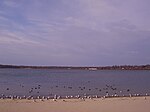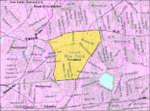Ronkonkoma, New York
Brookhaven, New YorkCensus-designated places in New York (state)Census-designated places in Suffolk County, New YorkHamlets in New York (state)Hamlets in Suffolk County, New York ... and 2 more
Islip (town), New YorkUse mdy dates from July 2023

Ronkonkoma ( ron-KONG-kə-mə) is a hamlet and census-designated place (CDP) mostly in the Town of Islip, With a small Eastern portion in the Town of Brookhaven in Suffolk County, on Long Island, in New York, United States. The population was 19,082 at the 2010 census. The Ronkonkoma post office has the ZIP Code 11779, and serves parts of several hamlets and CDPs adjacent to Ronkonkoma. Ronkonkoma is also home to Long Island MacArthur Airport, which is owned and operated by the Town of Islip. The New York Air Route Traffic Control Center is located in Ronkonkoma.
Excerpt from the Wikipedia article Ronkonkoma, New York (License: CC BY-SA 3.0, Authors, Images).Ronkonkoma, New York
Fir Grove Road,
Geographical coordinates (GPS) Address Nearby Places Show on map
Geographical coordinates (GPS)
| Latitude | Longitude |
|---|---|
| N 40.813888888889 ° | E -73.128333333333 ° |
Address
Fir Grove Road 422
11779
New York, United States
Open on Google Maps






